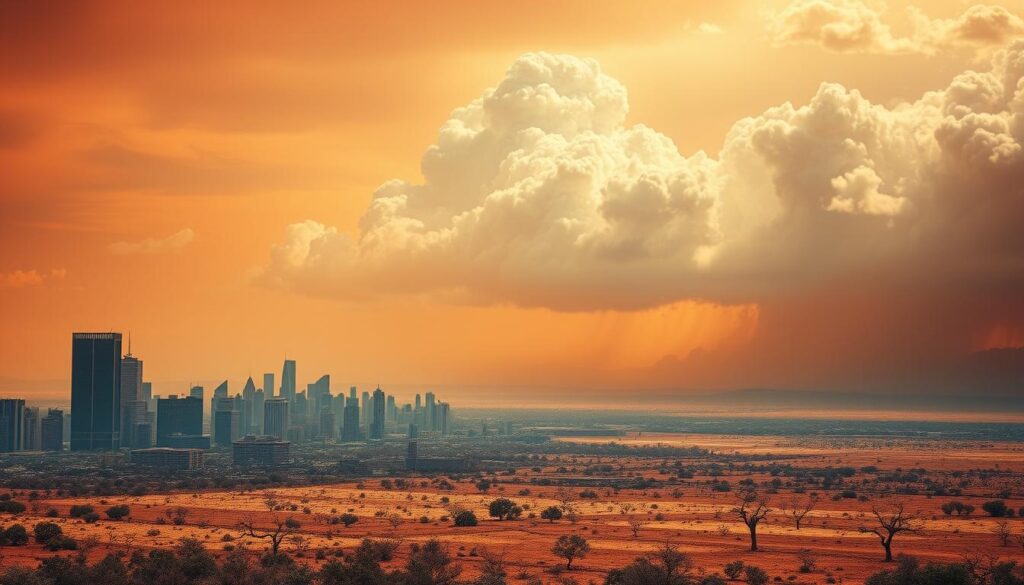Earth’s Hottest Year on Record What It Means for the Future

2024 stood out as the hottest year we’ve seen, with temperatures shooting up to 1.46°C to 1.62°C above what was normal before industries grew. This pushed the average to a sizzling 1.55°C, says the World Meteorological Organization (WMO). This jump in temperature signals a clear warning. It shows how quickly global warming is moving and the big challenges we face because of climate change. Halfway into 2024, we saw temperatures break records constantly, showing us a worrying sign of an emergency.
With 40% of people worldwide feeling this extreme heat, understanding its impact is crucial. It’s time we act and plan for a future that is safe and sustainable.
Key Takeaways
- 2024 confirmed as the hottest year on record, averaging 1.55°C above pre-industrial levels.
- Global temperatures set records each month from January to June 2024, extending a significant trend.
- 40% of the global population experienced their warmest year, impacting over 3.3 billion people.
- The rise in temperatures is linked to increased greenhouse gas emissions and climate anomalies.
- This record-setting heat raises urgent questions about future climate action and adaptation strategies.
Introduction to the Hottest Year on Record
Being named the hottest year on record, 2024 is a wake-up call in our fight against climate change. We must act now. The high temperatures are breaking records and bringing threats to our health and the planet’s well-being.
Everywhere around the world, extreme heat is pushing health risks higher and testing our limits. These climate changes bring unheard-of weather and affect living things and their homes. We are urged to find real solutions and think about what causes Earth to warm up.
We cannot ignore the changes in our climate any longer. Not acting will lead to terrible outcomes. We must come together and push for habits that will protect our future. It’s critical to spread the word, learn more, and work as one to solve this crisis. This era demands our joint effort and resolve to lessen its effects on Earth.
The Data Behind 2024’s Record-Breaking Heat
Understanding rising temperatures helps us see the big picture of climate change. The year 2024 set new high temperature records, showing a scary pattern worldwide. NOAA and NASA have been key in gathering and studying this critical data.
Temperature Records from NOAA and NASA
In 2024, the global temperature went up by a shocking 2.32°F (1.29°C) over the last century’s average. This rise confirmed 2024 as the hottest year so far. Areas like Africa, Europe, North America, Oceania, and South America faced their warmest year, with Asia and the Arctic not far behind. These numbers prove that the last decade had the ten hottest years since 1850, sending a clear message about climate change dangers.
Global Temperature Trends and Implications
The data point out not just the climb in temperatures but also the risks they bring. In 2024, temperatures went 2.63°F (1.46°C) above what it was before industry took off. These big changes impact weather, farming, and our health. Keeping an eye on these trends helps us tackle the climate challenge head-on.
Factors Contributing to 2024’s Extreme Heat
In 2024, the heat hit record levels due to many connected reasons. Greenhouse gas emissions played a big role, with carbon dioxide, methane, and nitrous oxide reaching new highs. This has made the causes of extreme heat even worse.
The Role of Greenhouse Gas Emissions
Last year, atmospheric carbon dioxide was about 422.5 parts per million (ppm). This was a big jump, showing we still rely a lot on fossil fuels. This rise has heated our planet, raising average temperatures by 1.55C since before the industrial age. In 2024, we saw temperature records break every month from January to June, showing a big increase in greenhouse gas emissions.
Impact of the El Niño Climate Pattern
The El Niño climate impact made 2024’s warmth even worse. This weather pattern makes ocean temperatures go up, changing weather worldwide. Because of this, the oceans got way hotter, adding 25 times more heat than what humans use in a year. So, land areas were about 2.3C warmer than in the past. This isn’t just because of climate change but also because El Niño happens in cycles.
Climate Change Impact on Human Health
Climate change does more than hurt the environment. It’s a big health risk, too. As the Earth gets hotter, heat-related illnesses go up. This is especially bad for those who are most at risk. We need to understand how climate change harms health, especially in poorer countries.
Heat-Related Health Risks and Vulnerability
Heat waves are hitting us more often and with more force. They bring a lot of health dangers. The World Health Organization says about 429,000 people die each year from extreme heat. Older adults and those with health issues face the biggest danger.
Poor areas suffer the most since they don’t have easy access to air conditioning or health services. This makes the health problems from warmer weather even worse.
The Disproportionate Effects on Developing Nations
Developing countries are hit hard by climate change. It makes health and money problems worse. Their weak systems can’t handle the growing heat and health troubles. These places are also more likely to get hit by bad weather, messing up clean water and healthcare.
Helping these countries is key to fighting the health effects of climate change around the world.
Weather Disasters in 2024
In 2024, extreme weather hit the United States hard. We saw 27 weather and climate disasters. Each caused damages of over $1 billion. This number nearly matched the record set the year before. We faced stronger and more frequent hurricanes, floods, tornadoes, and wildfires.
Increased Incidence of Hurricanes and Flooding
In 2024, hurricanes showed their destructive power. Five hurricanes hit, causing massive damage and loss of life. Hurricane Helene was especially deadly, with 219 deaths and $79.6 billion in damages. Climate change made flooding worse. A study found that climate change played a part in 15 out of 16 big floods.
Tornadoes and Wildfires: A Year in Review
Record-breaking tornadoes in 2024 caused $6.6 billion in damages and killed three people. Rising temperatures and drought led to many wildfires, especially in the West. These wildfires showed how these disasters are linked. All these extreme weather events cost about $182.7 billion, making 2024 one of the most expensive years.
Global Warming 2024/2025: What Lies Ahead
Looking to the future, we see a mix of global warming and La Niña’s effects. La Niña might cool the earth a bit. But, we must be careful. Unchecked emissions might bring back 2024’s extreme heat.
Potential Cooling Trends from La Niña
La Niña could give us a break from recent high temperatures. It has cooled the world before, according to history. But, it’s not a sure fix for global warming.
Long-term Predictions for Global Climate
Without cutting greenhouse gases, our future looks tough. Climate experts believe global temperatures will keep rising. The UN’s climate group says we need a big cut in emissions to control temperatures.
This means harsher weather, damaged ecosystems, and health risks could increase. We must act now to avoid these outcomes.

Environmental Impacts of Rising Global Temperatures
The alarming rise in global temperatures is hard to ignore. Significant sea level rises threaten coastal communities. Millions living near coastlines are affected by this key climate change challenge.
We are also seeing serious biodiversity effects. These compromise the balance of ecosystems across the world.
Sea Level Rise and Its Threats to Coastal Communities
Sea level rise is about 4.77 mm a year. It’s expected to speed up as temperatures rise. Coastal communities face flooding, erosion, and habitat loss.
Rising waters threaten infrastructure and livelihoods. The need to tackle these challenges is urgent. More people are becoming at risk.
Effects on Biodiversity and Ecosystems
Global warming’s impacts also harm biodiversity and ecosystems. Many species can’t adapt fast enough, leading to habitat loss and possible extinction.
Wetlands, forests, and coral reefs are under threat. These stressors reduce Earth’s biodiversity and disrupt ecosystem services.
| Impact Factor | Current Status | Future Projections |
|---|---|---|
| Sea Level Rise | 4.77 mm/year | Increased risk for 20 million people by 2050 |
| Species at Risk | Loss of habitat for 1 million species | Extinction rates could accelerate |
| Ecosystem Damage | Coral bleaching, deforestation | Further loss of biodiversity by 30% by 2030 |
Understanding the Climate Crisis
Today’s climate crisis is linked to rising global temperatures and more extreme weather. Statistics from 2024 show it as the warmest year on a global scale. That year, the temperature averaged 15.10°C, marking a 0.12°C increase from the year before. It was the first time temperatures soared past the 1.5°C mark above pre-industrial levels.
The Connection Between Temperature and Extreme Weather
A connection exists between higher temperatures and extreme weather events. The last ten years have been the hottest on record. On July 22, 2024, the global average temperature reached an all-time high of 17.16°C. Also, on July 10, about 44% of the world faced severe heat stress. This highlights the urgent need to understand the role of greenhouse gas emissions in temperature rises.
Public Awareness and Policy Response Needed
Fighting this crisis calls for strong climate policies. Raising public awareness is essential for encouraging sustainable actions and policies. By teaching communities about the impact of temperature changes, we can prepare for effective climate policies. Leaders must focus on reducing greenhouse gas emissions and promoting green practices to protect our future.
Global Warming Solutions for a Sustainable Future
We need a variety of strategies to tackle climate change, focusing on renewable energy and community support. By adopting new technologies and rallying communities, we can lessen global warming’s effects. Renewable energy, like solar and wind, cuts down harmful emissions and supports economic growth. Promoting community involvement builds resilience against climate change and pushes for strong climate policies.
Renewable Energy and Green Technology
Using renewable energy is key to fighting global warming. Switching to solar, wind, and other clean technologies reduces our carbon footprint. This shift also makes energy production more efficient. Communities benefit economically and become less reliant on fossil fuels. Companies like Tesla and NextEra Energy prove that renewable energy is crucial for our sustainable future.
Community Actions and Advocacy Efforts
Local advocacy is vital for tackling global warming. Groups like 350.org show how grassroots actions can make a difference. People working together can lead to policy reforms at both local and national levels. Efforts like tree planting, cleanup days, and education initiatives help protect our environment. These actions show our dedication to preserving the earth for future generations.

The Urgency of Climate Action
Our planet is warming up, showing us we must act fast on climate issues. If we don’t, we’ll see more extreme weather, rising oceans, and damaged ecosystems. We need to push for laws now to stop these effects. This means all governments should take strong steps to reduce harmful gases and save our environment. Making new laws is key because they help us follow eco-friendly ways.
Mobilizing for Legislative Change
Changing laws is a powerful way to fight climate change, a job too big for just one person. We need strong climate rules at both state and national levels. This tackles the big problems causing our climate crisis. Here are important areas to focus on:
- Setting tougher rules on industry emissions.
- Moving towards renewable energy sources.
- Putting more money into climate-safe buildings.
- Backing eco-friendly farming and land use.
These steps can make our environment more secure and show why we need laws to fight climate change. Let’s tell our leaders to focus on these areas for our kids’ future.
Individual Responsibility in Climate Solutions
Even though laws are important, our own actions matter too in stopping climate change. We all can make choices that help our planet. By changing how we live, we can lower our own pollution and encourage others to live greener. Here are some ways to make a big impact:
- Cutting down waste by recycling and composting.
- Using public transport or sharing rides to lessen pollution.
- Choosing energy-saving appliances and habits at home.
- Buying from eco-conscious local shops.
By adopting these green habits, we show how every person’s choices are important. Working together and starting local movements can spread the word and push for bigger climate solutions. Right now is a crucial time, and what we do, individually and together, will decide our planet’s future.
Lessons Learned from 2024’s Hottest Year
In 2024, we faced challenges that made us rethink how we deal with climate change. The huge heat and disasters made us question our ways of fighting climate risks. We learned that we need to change as global warming gets worse.
Reflection on Our Response to Climate Change
The heat waves in Asia in 2024 showed how critical a good response to climate change is. Places saw temperatures over 40°C, causing much suffering. The higher deaths in countries like Palestine, Bangladesh, and India showed the cost of doing nothing.
We understood we need to do better, especially as cities grow and more people live in poor conditions. When disasters hit, working together and sharing what we know is key. Climate change is making extreme heat way more common, especially in South Asia. It’s up to 45 times more likely, telling us our past actions weren’t enough.
Preparing for Future Climate Challenges
Getting ready for more challenges means focusing on being resilient and sustainable. The tough times in Asia in 2024 showed that schools suffered a lot. With schools closed, kids from families with less money were hit hardest. We must make plans that include teaching kids about climate change.
Betting on renewable energy is also crucial for our future. Investments in clean energy have gone up by 60% since 2015. It shows we’re committed to tackling climate change together. We need to invest in new technologies that are good for our planet. This way, we can fight climate change and help our communities thrive.
| Lesson | Details |
|---|---|
| Enhanced Response Strategies | Need for improved systems to address rapid urbanization and informal settlements. |
| Health and Safety Prioritization | Focus on protecting vulnerable populations from extreme weather impacts. |
| Collaboration and Knowledge Sharing | Importance of uniting efforts to tackle climate challenges holistically. |
| Investment in Renewable Energy | Increased funding for clean energy innovations as a path forward. |
| Education and Awareness | Integrating climate education into school curriculums for proactive future generations. |
Conclusion
In 2024, we saw the hottest year ever. It makes us think hard about climate change. We need to act fast. Going over the 1.5°C limit shows we’re past safe levels agreed upon in the Paris Agreement. The bad weather around the world, like the big drought in Madagascar, shows what will happen if we do nothing.
Madagascar faced extreme heat of 33°C to 39°C. Their crops failed because there was not enough water. This is a clear sign that ignoring climate change is dangerous. With more droughts and wildfires, we see how important it is to act. We must shift to renewable energy and follow through with strong climate plans. It’s urgent.
As we look to 2025, it’s a key moment for our climate efforts. We have to face these scary trends. And we need to protect our Earth for the kids of the future. The time to work together is now. Let’s lessen climate change’s effects and make a sustainable world for everyone. We can overcome climate change by standing united.
FAQ
What does it mean for 2024 to be the hottest year on record?
Saying 2024 is the hottest year means our planet’s climate is changing fast. It shows we need to act now to handle the dangers of global warming. These dangers include more extreme weather and health problems from the heat.
How do rising global temperatures affect human health?
Higher temperatures are bad for our health, causing around 429,000 deaths every year. The elderly and those in poorer countries suffer the most from these temperature increases.
What factors contribute to extreme heat like that experienced in 2024?
The main reasons for extreme heat are rising levels of greenhouse gases, especially carbon dioxide, which is now about 422.5 ppm. Another big factor is the El Niño weather pattern, which makes the ocean warmer and increases global temperatures.
What can we expect in terms of climate predictions for 2025?
In 2025, things might cool down a bit because of La Niña, but we shouldn’t let our guard down. If we don’t cut down on greenhouse gases, we could see temperatures spike again like they did in 2024.
How is climate change linked to extreme weather events?
There’s a strong link between the warming planet and more extreme weather like hurricanes and droughts. This shows why everyone needs to know about climate change and why we need strong actions to fight it.
What are some solutions to combat global warming?
To tackle global warming, we should use more clean energy from the sun and wind. Supporting green tech and encouraging everyone to act on climate change are also key steps.
Why is immediate climate action crucial?
We need quick action to fight climate change to avoid its worst impacts on health, nature, and the weather. Changing laws and living more sustainably are big parts of the solution.
How does climate change impact biodiversity and ecosystems?
Climate change is a threat to wildlife and their homes, leading to some species facing extinction. This shows how climate change affects all living things and their environments.
What lessons can we learn from the record heat of 2024?
The extreme heat in 2024 teaches us that we must get ready for more climate challenges. Sharing what we know and working together will help us adapt to global warming in the years ahead.











